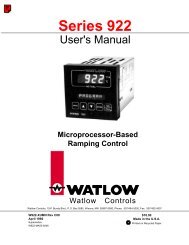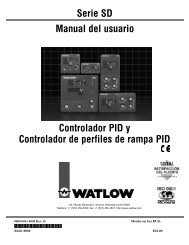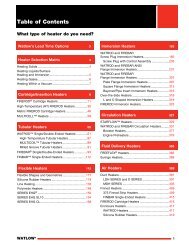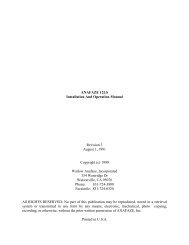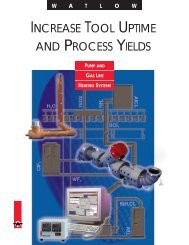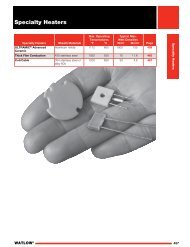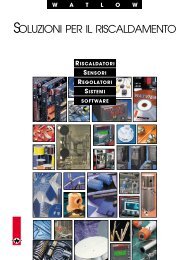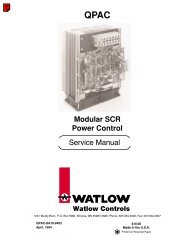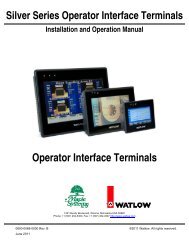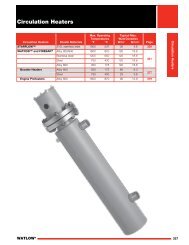Time/Temperature Control Series 733/734 - Watlow
Time/Temperature Control Series 733/734 - Watlow
Time/Temperature Control Series 733/734 - Watlow
Create successful ePaper yourself
Turn your PDF publications into a flip-book with our unique Google optimized e-Paper software.
AlarmsChapter 5 Alarm & Error CodesUsing AlarmsThe <strong>Series</strong> <strong>733</strong>/<strong>734</strong> has two alarm types, Process or Deviation. A Process alarmsets an absolute temperature. When the process exceeds that absolute temperaturelimit an alarm occurs. The Process alarm set points may be independently sethigh and low.A Deviation alarm alerts the operator when the process strays too far from setpoint. The operator can enter independent high and low alarm settings. The setpoint is the reference for the deviation alarm. Any change in set point causes acorresponding shift in the deviation alarm. Example: If your set point is 100°F,and a deviation alarm set at +7°F as the high limit, and -5°F as the low limit, thehigh alarm trips at 107°F, and the low alarm at 95°F. If you change the set point to130°F, the alarms follow the set point and trip at 137°F and 125°F.˜NOTE:A dash "_" can beeither a 1 or 2 whichrepresents Zone 1or Zone 2 respectively.˜NOTE:An alarm displaywill be masked byan error conditionor when the controlis in the Setup,Service or Calibrationmenus.Both process and deviation alarms can be latching or non-latching. When thealarm condition is removed a non-latching alarm automatically clears the alarmoutput. You must manually clear a latching alarm. See below.Flashing "LO _" or "HI _" in the display indicates an alarm. The display alternatelyshows information from the current parameter and the "LO _" or "HI _" alarmmessage at one second intervals. If an alarm condition exists, the alarm output isde-energized. An alarm condition does not effect the control output.To clear an alarm…• First correct the alarm condition, then…• If the alarm is latching…Clear it manually as soon as the process temperature is inside the alarm band(below A_HI and above A_LO).Enter the Program mode by pressing the keys simultaneously for 3seconds.Press the Menu 12 12 key once. Next, press the <strong>Time</strong> key . The Ac (AlarmClear) prompt is displayed. Press the <strong>Temperature</strong> key and the alarm iscleared. Pressing the <strong>Time</strong> key twice, takes you back to the Operationmode [0)º0].• If the alarm is non-latching…The alarm clears itself automatically as soon as the process temperature is 3°Finside the fixed alarm limit.Alarm Silencing is available with either the process or deviation alarm in latchingand non-latching mode. On initial power up, alarm silencing disables the alarmmessage and the alarm output relay. Once the process value crosses into the"safe" region, the latching or non-latching alarm is enabled. Any future deviationoutside this safe band triggers an alarm message and the alarm output relay deenergizes.On dual zone controls, both process values must cross into the saferegion before either the latching or non-latching alarm is enabled.12 WATLOW <strong>Series</strong> <strong>733</strong>/<strong>734</strong> Program ManualAlarms & Error Codes, Chapter 5



